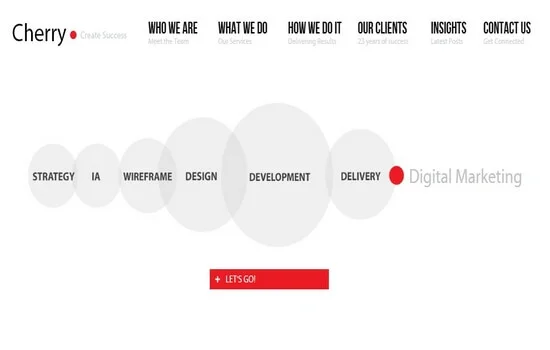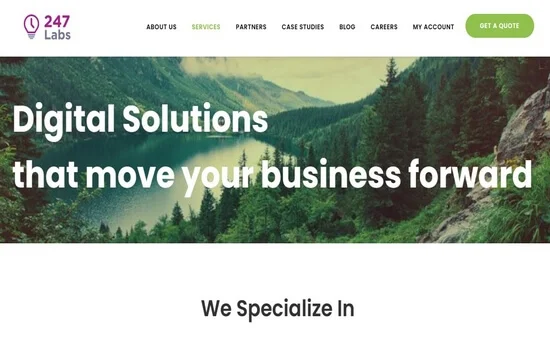The digital realm opens many doors, yet crafting an online presence demands diverse expertise that few lone individuals can provide on their own. Now, businesses across Canada are increasingly recognizing the importance of a strong web presence. Not only to connect with customers but also to gain new clients in today’s internet-focused world.
The need for full-service web development agencies capable of guiding organizations smoothly through design, development, and ongoing optimization has grown. We have listed some of the top firms nurturing Canadian entrepreneurship through strategic and skillfully executed website development and designing solutions.
Top 5 Web Development and Web Desing Companies In Canada
Whether you require a stunning website, a custom web application, a fully-fledged ecommerce store or comprehensive digital marketing solutions, these exceptional companies are ready to take your business to new heights. Read on to discover how these companies can help you elevate your online presence and dominate the digital landscape.
1. Digital Monk Marketing

Digital Monk understands the confusing feelings of every website and business owner all too well. Their team treats each client like a friend’s needing guidance across unfamiliar terrain, not just another contract. With care and wisdom honed over the years in the online space, they assess goals, ask thoughtful questions and map out tailored roadmaps others can actually follow.
Every data-driven strategy aims to speak the language real people relate to and that’s what makes it the best web development company. Each finished website balances aesthetics and utility, giving you an advantage over others. For Digital Monk, metrics matter, but nothing compares to the reward of empowering others’ passions to thrive thanks to thoughtful online spaces designed to uplift.
2. Red Cherry Inc

The web artisans at Red Cherry recognize powerful websites blend science and soulfulness. Sure, clean code and savvy tech underlie it all, but they believe people should stand at the center. With strategists, creative directors and advisors collaborating, they craft custom sites, realizing the uniqueness of each client’s brand story.
Whether you want to develop an ecommerce website or are searching for a partner for a custom web project, Red Cherry is always there to help. Red Cherry celebrates that websites make connections, satisfying both audiences and business goals most beautifully when built upon relationships, trust and a few rounds of revisions to get things just right.
3. Parachute Design Group Inc.

Every business wants to feel confident in online spaces, yet uncertainty around marketing technicalities overwhelms all too readily. Parachute Design believes growing digital fluency should feel within reach, not anxiety-inducing. Just as parachutes provide safe landings, they guide clients into digital confidence.
It is basically a Toronto web design company providing exceptional web services to brands and businesses around the world. Plain language and thoughtful listening help uncover core priorities while their systematic blueprint removes the guesswork. With SEO, advertising and social techniques tailored to each brand’s ethos, Parachute fosters organic online growth.
4. 247 Labs Inc

247 Labs believes client care and communication are equally key, and that is why their developers and accountability managers collaborate closely across each web build to nurture understanding on both ends. With patience and transparency around timelines, support teams walk clients through unfamiliar territory, protecting budgets and peace of mind along the way.
The company has claimed to work with brands like Ubisoft, Motorola, Johnson & Johnson, Coles and many more. From websites to ecommerce stores and mobile applications, they develop every web identity to help you reach more people online. Every line of flawless code and scalable cloud solution has a human relationship at its foundation.
5. Consensus Creative

The barriers between strategy and execution should blend seamlessly, according to Consensus Creative. Just as inclusive communication yields better outcomes, rallying around shared online visions fosters harmony between client needs and audience experiences. Their dedicated managers ensure the client’s expectations are heard and noted.
With messaging aligned around users’ actual mindsets, the best website development company work to appeal to potential customers. Many clients have rated them 5/5, not just for their work but for the fantastic support they offer. Not only for website development and design, but you can team up with them for copywriting, SEO, branding, and web maintenance services, too.
Things To Look For In A Web Development Agency
Choosing the right app and web development company for your business feels like a daunting task. There are so many companies out there these days; how do you know which one will go the extra mile for you? Well, worry not because here are some key things we consider and suggest every business to consider when searching for expert web developers in Canada:
Experience
Going with an experienced company just feels safer. You want to work with a team that’s been around the block and has tackled projects similar to yours before. That way, they understand the challenges you might face. You must pay close attention to how long they’ve been in business and the variety of clients and sites they’ve worked on over the years.
Portfolio Quality
It’s comforting to see examples of beautiful, functional websites a company has delivered. Diving into portfolio sites gives you a feel for the care, creativity and technical skill that might go into developing your site. You will definitely be impressed by portfolios with sites optimized for all devices and whose designs really pop with personality.

Development Process
An organized, client-focused development approach is key. Carefully listening to clients ensures requirements are understood, and the finished product truly suits needs. Streamlined workflows and communications keep projects on track. Thorough QA testing protects from issues disrupting launch day joy.
Technical Proficiency
At its core, developing a web identity requires technical wizardry. Web development and designing companies staying current on all the latest languages, frameworks, and security practices gives faith they can solve problems. Ensure that the top web development companies you are partnering with have strong foundations when it comes to tech stack.
Client Satisfaction
Looking at reviews from real customers in similar situations as yours, especially ones who have been clients for years, will help you understand so much about quality of service and how issues will be handled. Choose a company with a high volume of glowing feedback to have reassurance for the future and get the best-deserved service.
Final Words
By learning what distinguishes the best partners and thoughtfully assessing offerings, any company can find the perfect web development ally.
Top web development agencies in Canada empower enterprises just starting digital adventures or seeking advantage amid industry shifts. Their guidance navigates evolving landscapes and taps infinite opportunities.
So, explore recommendations, consult proven specialists, and watch a strategically crafted web presence perform miracles for your brand. Innovation becomes an effortless ally with the right digital advocate.
